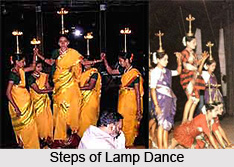 Lamp dance is one of the famous dances of Goa and is presented by Goan peasant community. This dance derives its name from brass lamps used in the dance during the Shigmo festival in the month of March. Lamp dance is also called the "Divlyam Naach" that re-supposes cohesion of movements on the part of all the members of the group. The lamp used in this dance represents a traditional Goan handicraft. This dance is popular in the southern and central Goa.
Lamp dance is one of the famous dances of Goa and is presented by Goan peasant community. This dance derives its name from brass lamps used in the dance during the Shigmo festival in the month of March. Lamp dance is also called the "Divlyam Naach" that re-supposes cohesion of movements on the part of all the members of the group. The lamp used in this dance represents a traditional Goan handicraft. This dance is popular in the southern and central Goa.
Performance of Lamp Dance
Lamp dance is performed in a group. It is practiced by both the male and female dancers. The dancers indulge in a slow dancing movement, balancing brass lamps with burning wicks (Divli) on the head and the hands. Holding the lamp on head requires tremendous gymnastic skills. The balancing act demands tremendous control and self-discipline. The performers need to be highly skilled and expert in their performance. The exquisite footwork matching with the rhythms of the traditional folksongs are eye-catching.
Instruments of Lamp Dance
The lamp dance is accompanied by various musical instruments which include Ghumat, Samael, Cymbal and Harmonium.
Costume of Lamp Dance
The dancers usually dress themselves in attires like sari. The rule of wearing the sari varies according to groups and performances. Ornaments like bangles and necklaces are worn by the women to complete the look.
This article is a stub. You can enrich by adding more information to it. Send your Write Up to [email protected]



















